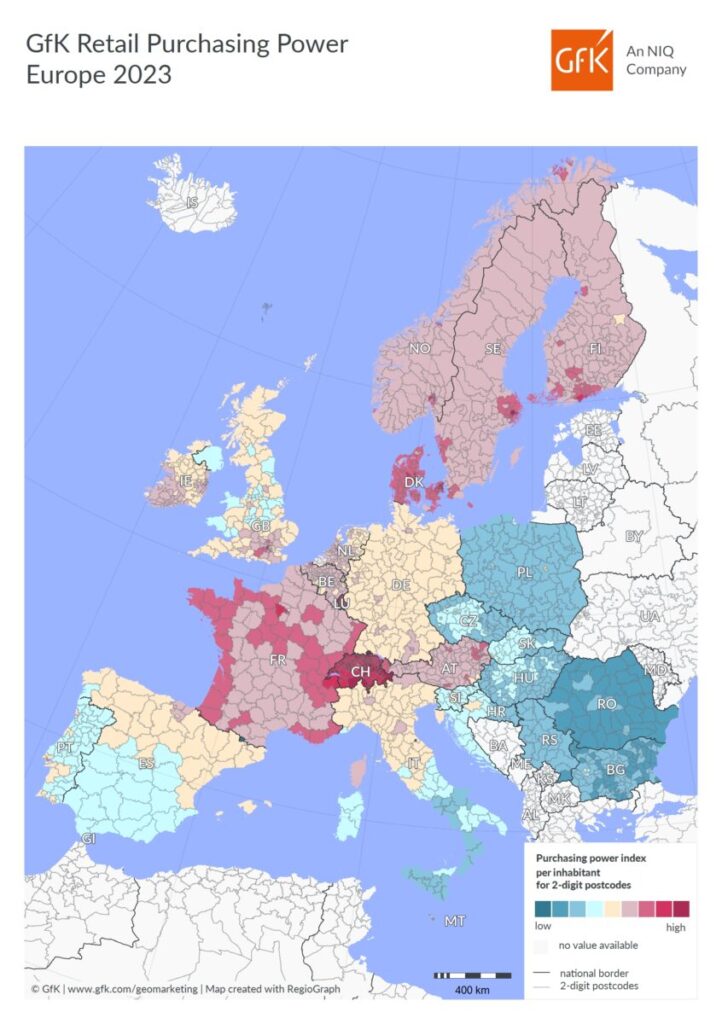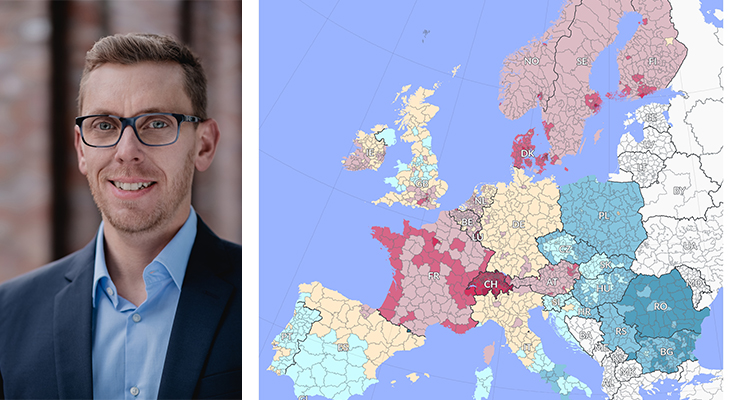The inhabitants of the 25 European countries considered by the study have a total of almost 3.4 trillion euros at their disposal to spend on retail, which corresponds to an average retail purchasing power of 6,517 euros per capita. This puts frontrunner Luxembourg, where people have 12,067 euros for retail expenditures, more than 85% above the European average. Switzerland and Denmark follow in second place and third place. While the per capita retail purchasing power of the Swiss is more than 78% above the average at 11,617 euros, the inhabitants of Denmark have a retail spending potential of 9,479 euros per capita. This puts them almost 46% above the European average.
RETAIL PURCHASING POWER IN EUROPE
| Ranking | Country | Inhabitants | Per capita retail purchasing power in euros | European retail purchasing power index* |
| 1 | Luxembourg | 660,809 | 12,067 | 185.2 |
| 2 | Switzerland | 8,738,791 | 11,617 | 178.3 |
| 3 | Denmark | 5,932,654 | 9,479 | 145.5 |
| 4 | Finland | 5,563,970 | 8,711 | 133.7 |
| 5 | France | 65,834,837 | 8,634 | 132.5 |
| 6 | Sweden | 10,521,556 | 8,352 | 128.2 |
| 7 | Norway | 5,488,984 | 8,284 | 127.1 |
| 8 | Austria | 8,978,929 | 8,041 | 123.4 |
| 9 | Belgium | 11,697,557 | 7,666 | 117.6 |
| 10 | Ireland | 5,149,139 | 7,467 | 114.6 |
| 11 | Netherlands | 17,811,291 | 7,314 | 112.2 |
| 12 | United Kingdom | 67,026,292 | 6,685 | 102.6 |
| 13 | Germany | 83,237,124 | 6,667 | 102.6 |
| Europe 25 | 515,168,467 | 6,517 | 100.0 | |
| 14 | Spain | 47,475,420 | 6,017 | 92.3 |
| 15 | Portugal | 10,467,366 | 5,892 | 90.4 |
| 16 | Italy | 58,850,717 | 5,861 | 89.9 |
| 17 | Slovenia | 2,116,972 | 5,612 | 86.1 |
| 18 | Croatia | 3,862,305 | 5,318 | 81.6 |
| 19 | Slovakia | 5,428,792 | 4,914 | 75.4 |
| 20 | Czech Republic | 10,827,529 | 4,753 | 72.9 |
| 21 | Hungary | 9,599,744 | 4,572 | 70.2 |
| 22 | Poland | 37,766,327 | 4,051 | 62.2 |
| 23 | Serbia | 6,641,197 | 3,977 | 61.0 |
| 24 | Bulgaria | 6,447,710 | 3,808 | 58.4 |
| 25 | Romania | 19,042,455 | 2,986 | 45.8 |
The country closest to the average is Germany, where people have 6,667 euros available for their retail spending. However, the share of retail spending in general purchasing power, that is, net disposable income, is very low in Germany, as it is in Switzerland and the UK. In many Eastern European countries, on the other hand, especially in Hungary and Croatia, the retail share of general purchasing power is very high at up to 50 percent. This is mainly due to the fact that people in those countries have lower incomes and, therefore, spend larger proportions in the retail sector.
Overall, 13 of the 25 countries have above-average per capita retail purchasing power. In contrast, 12 countries have below-average per capita retail purchasing power. Romania brings up the rear with 2,986 euros, which corresponds to just under 46% of the average.

general purchasing power, purchasing power for retail product lines, inhabitants and households. More Information: geodata.gfk.com
However, there are also significant differences within European countries in terms of potential retail spending. A look at the regional distribution in the United Kingdom, for example, shows that retail purchasing power in the western part of London is twice as high as the national average and is even 2.6 times higher than the lastplaced region of Sunderland. In general, it can be observed that the regions in and around many European capitals have above-average retail purchasing power. In addition to the UK, this is also the case in France, Hungary, and the Scandinavian countries, for example.

Filip Vojtech
Filip Vojtech is a Retail Expert in GfK’s Geomarketing business area.






